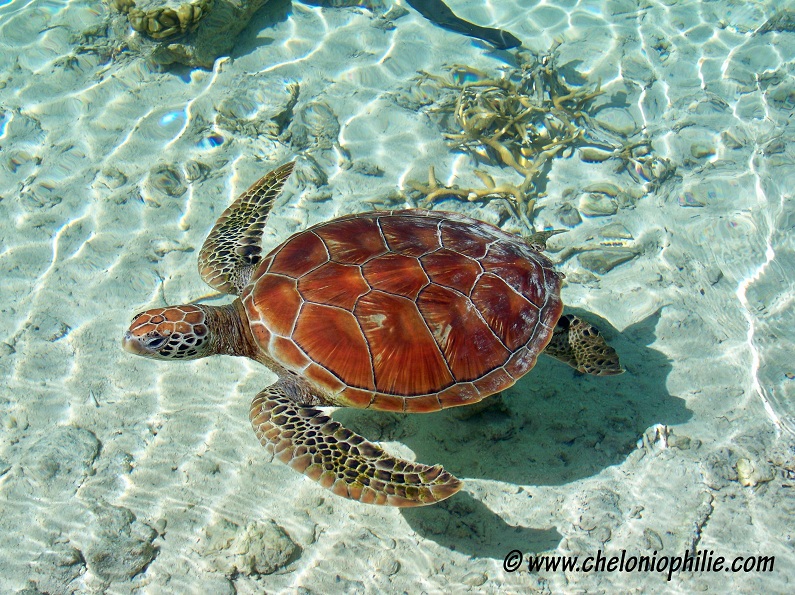
French Polynesia offers an oceanic sanctuary

Protection and sustainable management of marine ecosystems in Tahiti and her Islands
French Polynesia offers an oceanic sanctuary of 4 million square kilometers to its emblematic marine turtles, formerly said to have the power to guide the souls to the afterlife:
Around the world, sea turtles are regarded endearing and vulnerable, just like dolphins and whales. It is undoubtedly our imagination and what remains in us of our past children’s sensitivity that lead us to consider the marine turtles with so much sympathy. The stories and tales we read in our childhoods’ days certainly helped to shape this perception and affection to the specie. But the adults we have become, also want the marine turtles to survive … And this is not only because we recall our children’s’ dreams in which turtles played the role of some unforgettable personages: It is mainly because our consciousness as responsible adults, leads us to ardently wish effective protection of the marine environment and endangered species, along with radical condemnation of the cruelty, inhumanity and irresponsibility of poaching of which turtles are still victims, just like other species …
In Tahiti and her islands, the marine turtle is affectively ingrained in the collective imagination. Turtles often are at the heart of many legends and they attract both sympathy and empathy. In the Polynesian culture, marine turtles are emblematic of the incredible biodiversity of our waters: If turtles return to us each year to frequent our lagoons, then it is considered that the ocean and the fauna that inhabit it are still in good health. Moreover, in the culture of our islands, the tortoise (“honu” in the Maohi language) symbolizes peace of mind, family harmony and fertility. The ancient Polynesians also saw in turtles some navigators inspired by the gods and even guides to the “world of beyond”; this because the tortoise represents the link between the earth (that symbolizes humans) and the sea (that symbolizes the “other world” and the “afterlife”). Thus, the Polynesians of the ancient times believed that the sea (which their survival was entirely dependent upon) was the “beyond” and the “afterlife”. Therefore, they trusted that if the turtles could keep on moving freely between land and sea, there would still be guides to lead them one day to the world of eternal rest …
In Tahiti and her islands, turtles are threatened by the scarcity of nesting sites (isolated beaches are fewer in number than in the past) and poaching that unfortunately, continues; although it is strictly forbidden to hunt turtles or to consume and market their flesh. The egg-laying sites are the islands of Tupai, Scilly, Bellingshausen, Mopelia and Tetiaroa. There are 5 species of turtles in French Polynesia. The time when turtles are most vulnerable is the laying period that begins in October and ends in March. All species of marine turtles in Polynesian waters are protected. But it remains difficult to enforce the law in such a large territory (4 million square kilometers, or about the size of Europe). Since 1971, the French Polynesian government has acquired the human resources and legal tools necessary for the protection of marine turtles: The Polynesian sea turtles observatory was created. It is an independent body of which management was granted to the “Te mana no te Moana” (“the spirit of the ocean” in Language Maohi) association. The Polynesian marine turtle observatory is a well-structured and effective participatory management tool: It trains local populations and involves them in the collection of data, while regularly launching awareness campaigns and exemplary actions in collaboration with major public or private structures (the hotel “Le Brando” in Tetiaroa has thus accepted to filter its lights by night, to limit considerably its noise nuisances and to sensitize its customers to the respect of the turtles coming to lay on the atoll beaches) …
In Tahiti and her islands, marine turtles have come to symbolize the survival of life in the ocean. They are a marker of the resilience of the species that our deleterious and suicidal life-style has almost condemned. They also symbolize the hope of a better life in which man would understand that his own survival and that of his civilization are dependent on respect for the environment and maintenance of biodiversity. The protection of marine turtles is a strong act that goes far beyond the simple concern of preserving the environment, it is an act of civilization … We in Tahiti and her Islands like to know that our emblematic marine turtles are protected. And we do protect them with proactivity, voluntarism, efficiency and scientific professionalism.



















